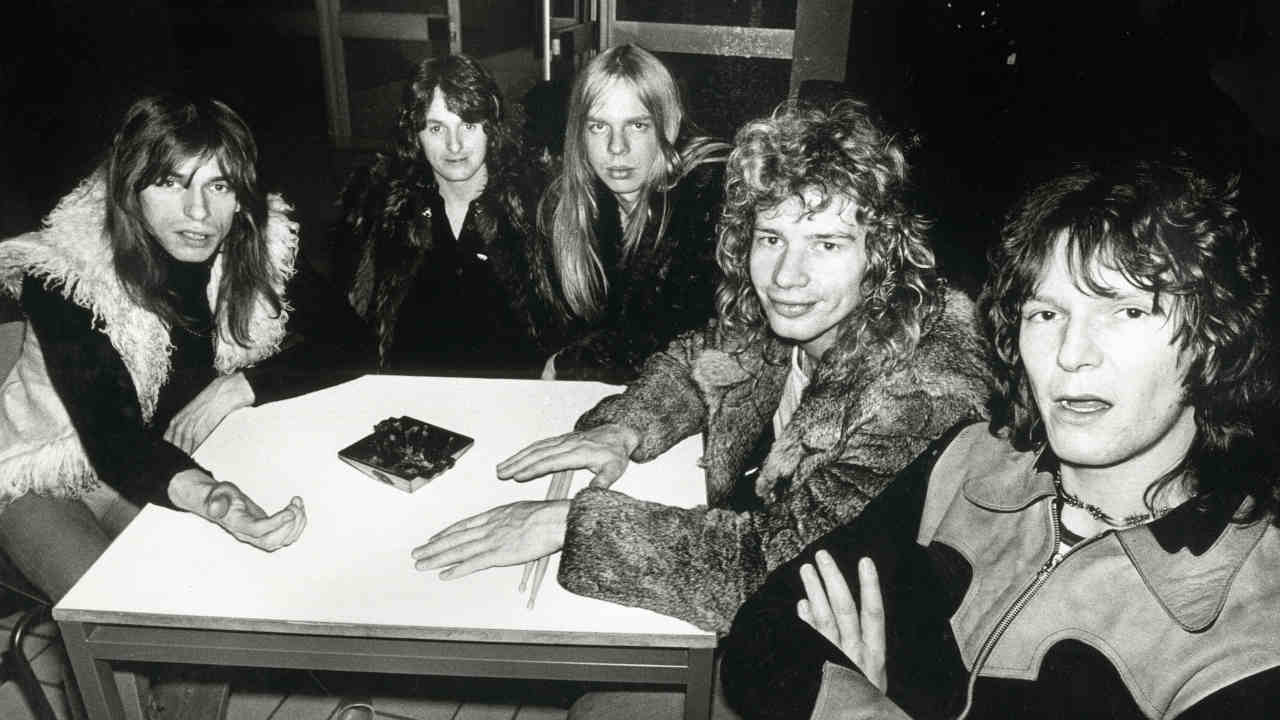
From his epic 70s solo concept albums to his work with everyone from David Bowie to Black Sabbath, Rick Wakeman has a vast back catalogue. But the keyboard wizard’s most famous work is with prog pioneers Yes. In 2012, looked back over his tangled, turbulent and often hilarious relationship with his old band.
Between mouthfuls of morning coffee, Rick Wakeman is trying to summarise his time with Yes, the band that he joined in 1971, and left, for the fifth and apparently final time, in 2005.
“Someone once likened it to the marriages of Richard Burton and Elizabeth Taylor, inasmuch as we can’t live with each other and we can’t live without each other,” he says. “And I can agree with that, as long as I’m Richard Burton…”
He laughs at the thought. While he has made a nice living of late as one of television’s Grumpy Old Men, Wakeman comes across as jovial and sometimes mordantly funny when reminiscing about leaving and rejoining a band that has served him up equal doses of the sublime and the absurd.
“It was the music that held us together, and probably the rest of it that made life difficult,” he says. “What other job can you tell me of where you have breakfast with the people you work with? And you’re then travelling to work with the people you work with, you’re working solidly, having lunch, you’re having dinner, and performing with them. The only time you don’t see them is when you go to your room. I don’t care how much you like the people you work with, you’d want to kill them after a week. Well, that’s what happens with bands…”
Throughout our conversation, the many and various members of Yes pop in and out of the story like recurring characters in a quirky soap. He is closest to Jon Anderson, with whom he has twice quit the band in solidarity, and is generous in his praise for Steve Howe, Chris Squire, Alan White and Bill Bruford, with whom he has periodically disagreed. He selects 90125, an album that he didn’t appear on, as the most important of the band’s career (“It saved Yes”), speaks highly of Trevor Rabin, and turns out to be a big fan of the Buggles, who, in perhaps Yes’s strangest interlude, replaced him and Anderson for the Drama record.
When he’s not in the band, he faithfully buys each album that they produce, “because I’m a Yes fan too.” Although he may never play with them again, and while acknowledging the many millions of records he has sold as a solo artist and the untold others he contributed to as a session man, it is with Yes that he will always be remembered, the man whose virtuosity so enhanced songs that are now part of rock‘n’roll’s canon.
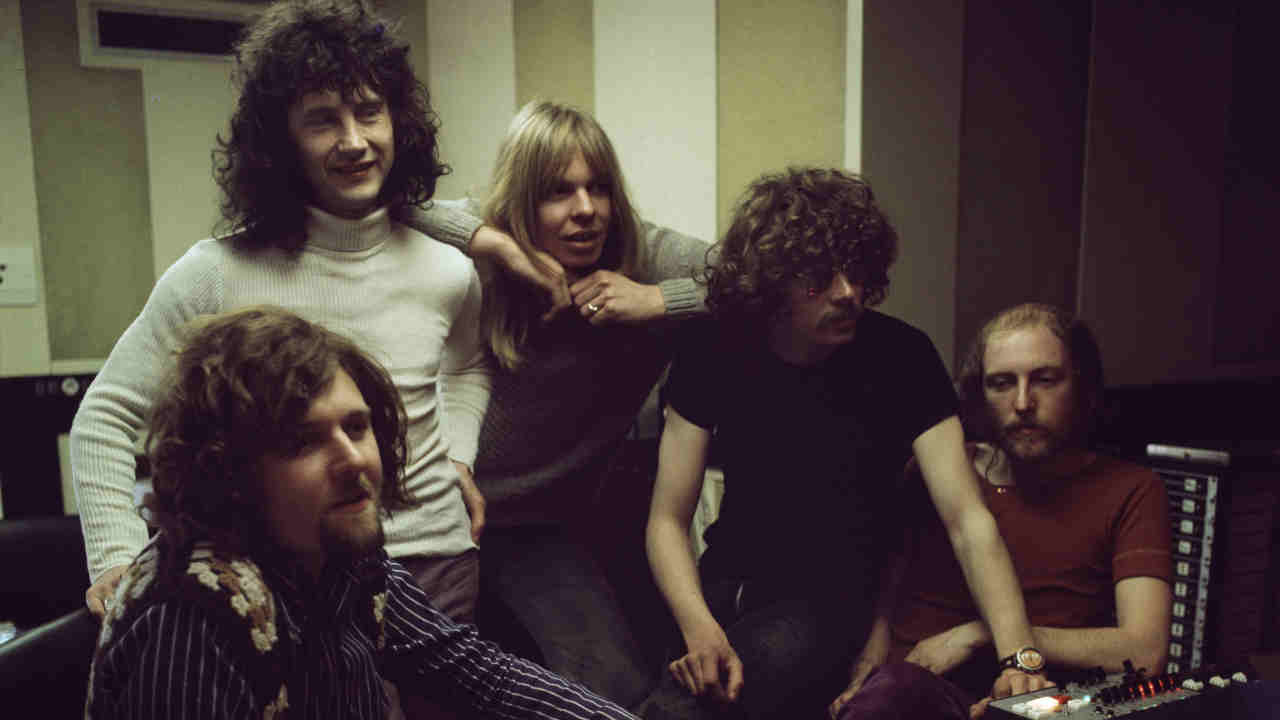
Wakeman was still a member of the Strawbs when he first saw Yes play, in 1970 in Hull, where the bands shared a bill. His memory of the night is still sharp four decades later, such was the impression that it left. What struck him was how different Yes were.
“The other guys in Strawbs went back to the B&B, and I stayed to listen,” he says. “In those days, every singer was six feet two, long greasy hair and had a rock‘n’roll tenor voice. On comes this bloke, five feet nothing, with an alto voice. Every guitarist had a Marshall stack with a Fender Strat; on comes this guitarist with a semi-acoustic Gibson and twin Marshall amps. Every bass player was playing Fender Jazz basses; on comes this bass player who’s like six feet six playing a Rickenbacker bass – and at that time Rickenbacker was so out of fashion, you couldn’t give ‘em away. And he had amps, Sunn amps, that I’d never heard of, and he had all the bass on flat out, all the treble on flat out and wound all the middle out. What really freaked me out was this drummer, Bill Bruford, who did not play like a rock drummer. He was technically astounding. I was fascinated.”
His time in the Strawbs was coming to an end, hastened by the band’s move away from folk rock and towards pop. At around the same time, he gave an interview to Chris Welch at the Melody Maker where he set out one of his great ambitions: to use his small but growing collection of Mellotrons and electric pianos to bring a more orchestral sound to rock music.
“I got a phone call at two o’clock in the morning from Chris Squire, this was at the beginning of July 1971,” he says. “I was living in a little house in Harrow and I came home from some sessions. I didn’t get in till about one, and I had to be up at five because I had more sessions in London the next morning. I crawled into bed and the phone went. ‘Hello, this is Chris Squire.’ I remember saying to him, ‘Do you know what time it is?’ He said, ‘Hold on a minute, I’ll have a look’, and went away. He came back and said, ‘It’s two o’clock… Anyway, we all read your article in Melody Maker. We’ve decided to have a bit of a change in the line-up and go down a more orchestral rock route. Would you like to join the band?”
Squire’s approach was followed up the next day by Yes’ manager Brian Lane (“a very, very bright boy”), who arranged a rehearsal in Shepherd’s Market, Mayfair, in a room above a brothel.
“I went up the stairs and they were all there, nothing seemed to be happening,” says Wakeman. “And then Chris said, ‘Well, I’ve got this riff’. And it was the running up line from Heart Of The Sunrise. Steve said, ‘Yeah that’s nice’, and joined in and played it. So I joined in. Steve said, ‘Actually it works coming down too’. Bill played something else. I said, ‘Well it’s fine, but the only problem is, you can’t keep doing it. It becomes very King Crimson-ish. If you have some chords over the top, it will make a lot of difference’. I found some pretty weird chords, and Jon said, ‘I’ve started a song’. By the end of the day, we’d pretty much written Heart Of The Sunrise.”
The day wasn’t quite finished with Wakeman yet, either. “Steve said to me, ‘Where do you live?’ I said I lived in Harrow. He said, ‘I live in Hampstead, you couldn’t drop me off home could you?’ So I drove him home, and he said, ‘Oh, you couldn’t pick me up in the morning could you, about 11?’ I said sure. It was only when I was driving back to Harrow that I thought, ‘I think I’ve just joined Yes’. The following day, I got a phone call from David Bowie. He wanted me meet him at Hampstead Country Club. I thought great, I’ll be dropping Steve off, and I can go in and see David. So I popped in, and there was David with Mick Ronson. David said, ‘I’m forming a band called Spiders From Mars and I want you and Mick to run it’. I said, ‘Oh blimey, I’ve just been asked to join Yes’.
“You can look back now and say it’s like being asked to sign for Chelsea and Man United, but it wasn’t like that at the time. I loved David’s stuff. I remember weighing it up when I was driving home. David was a bigger artist. Hunky Dory had been a huge hit. But if I’m part of the formation of Spiders From Mars, great as it is, I’ll be playing David’s stuff all the time. And I want to be part of introducing my own music into something. So I called him the next morning, and he was brilliant. He said, ‘I think you’ve made the right decision’. And in fact he reiterated that. We became neighbours when I was living in Switzerland in the 70s. We used to see each other a lot down a club called the Museum Club. We talked about it a lot, and he said, ‘You went on to do the right thing’. And it’s true: almost every project David did, he put a different batch of musicians together. The Spiders didn’t last that long.”
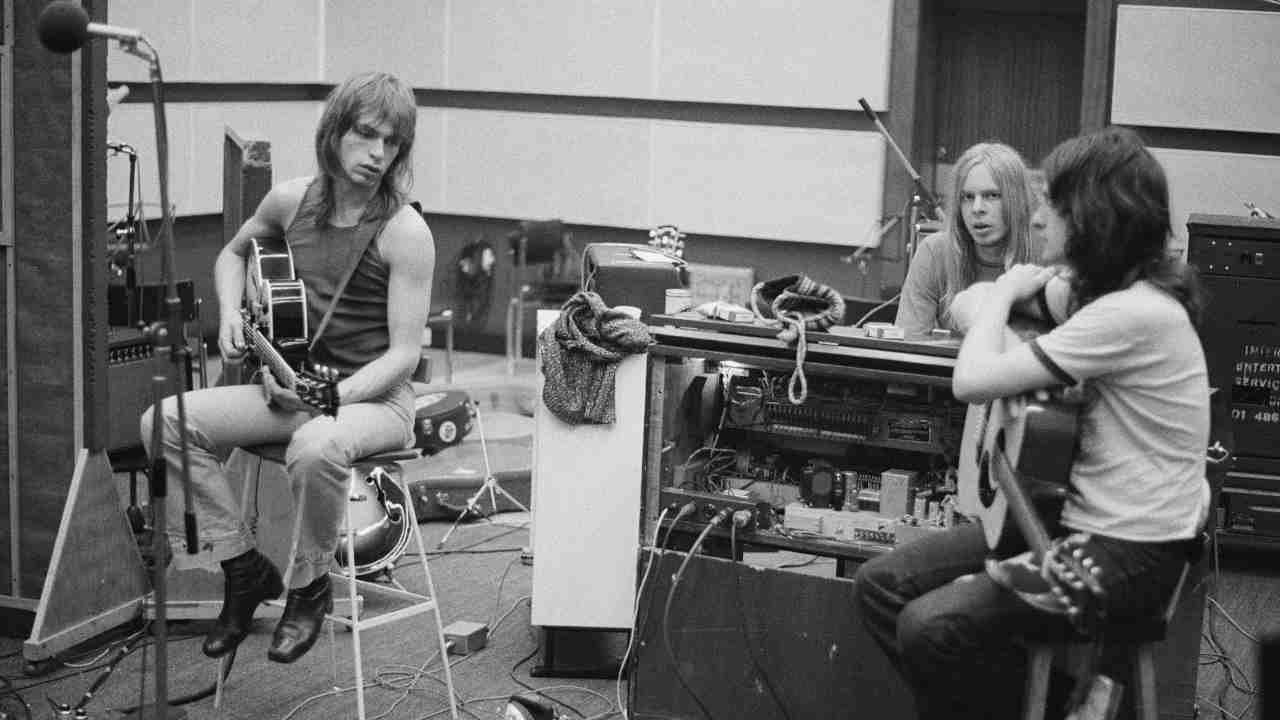
So began an extraordinary run of creativity, for both Wakeman and Yes. From 1971-75, Yes made Fragile, Close To The Edge and Tales From Topographic Oceans, plus a triple live album, Yessongs, while Wakeman also issued The Six Wives Of Henry VIII, Journey To The Centre Of The Earth and The Myths And Legends Of King Arthur. Wakeman went from his tiny house in Harrow to more traditional rock star retreats – a farm in Devon, a house in Switzerland – but in truth it didn’t really matter where he lived, because his life was on the road, thrown together morning noon and night with his bandmates. They worked obsessively on their music.
Steve Howe describes the impact that Wakeman made on Yes: “The dichotomy was, although he had that classical training and the serious side, his drinking and his good time nature was maybe further on than we were. We were more reclusive, a little bit more serious and Rick had a sort of lightness. His training was counterbalanced by our seriousness and determination. We wanted him to play every kind of keyboard, from harpsichord to MiniMoog, and so did he. We wanted to avoid becoming the overspill from blues in rock. I didn’t find that agreeable. When we started writing Close To The Edge, we started talking bigger, bigger. We started getting new age really, we got kind of floaty and gloomy, and those bits make the other bits sound even more powerful.”
They first went to America in November 1971, playing as a fourth on the bill act while the arenas filled for headliners like Ten Years After and Black Sabbath. But as Fragile and Close To The Edge began to sell in large numbers, Yes moved up, and began drawing a different, more serious crowd.
“What was quite fascinating was that a lot of bands wouldn’t come out and play with us,” says Wakeman. “I dunno whether they felt intimidated or whether they thought we were all mental, or that, with our music being very, very prog rock, we were getting a very prog audience, people who wanted to listen and go with the music. We met the Eagles, who became great friends, and we did a lot of dates together. All was going very, very well, and we did the Yessongs triple album, a live album that again did extraordinarily well. Because we’d become so successful, it tended to overshadow anything that anyone might think. Then we came to start writing the next album, which of course was Tales From Topographic Oceans…”
It was that record, a four-part ‘suite’ of songs, one per side of vinyl, which was to precipitate Wakeman’s first and most famous departure from the band. By the time they had toured it through America, Japan and Europe, he had become alienated both by the some of the music, and by his relationships with his bandmates.
“To put it blatantly, we were pretty much pot-smoking hippies and Rick was a pub guy,” remembers Chris Squire. “Some of the magic comes when you knit someone in who isn’t like the last person.”
Wakeman, though, was coming unknitted, staging silent protests against the excesses of Tales... by ordering curry to eat onstage during some of its wiggier sections.
“On vinyl you could put at best maybe 19 minutes per side,” says Wakeman. “We’d put together four pieces; there were some good songs, some nice themes. But some of the pieces might have been eight minutes, some were 15, one was 12. We had too much for one album, but not enough for a double. If we’d edited it down to be a single album it would have been a great album. But we ended up padding it out, almost jamming in the studio and going, ‘Yeah that’ll be alright, throw that on’. I argued, ‘We can’t do this’. But I got outvoted, and I was quite upset about it. It was a very difficult situation. We finished the album, and I didn’t like it because I could hear all the padding bits. It was a very strange album. The Yes fans either loved it or hated it, and I was one of those who hated it.”
He gave notice to the band, but no-one really believed he meant it. He was in Devon at his farmhouse. “It was 18 May, 1974. I know that, because it was my birthday. I remember standing in the kitchen and the phone rang. It was Brian (Lane), and he said, ‘What are you doing in Devon?’ I said, ‘Well, I live here half the time’. He said, ‘You’re supposed to be at rehearsals’. I said, ‘Brian, I’ve left.’ He said, ‘You’ve really left?’ ‘Yes, I’ve really left.’ Put the phone down. Two minutes later, the phone rang again and it was Terry O’Neill from A&M records. He said, ‘I’ve got great news for you. Journey To The Centre Of The Earth is No. 1, the first No. 1 album A&M’s ever had in the UK’. I went, ‘Oh right’. He said, ‘Well you don’t sound very bloody happy, we’re all celebrating here.’ I said, ‘Terry, this has to be between you and me, but two minutes ago I officially left Yes.’ He said, ‘Oh bloody hell.’ I said, ‘Yeah, and it’s my birthday…”
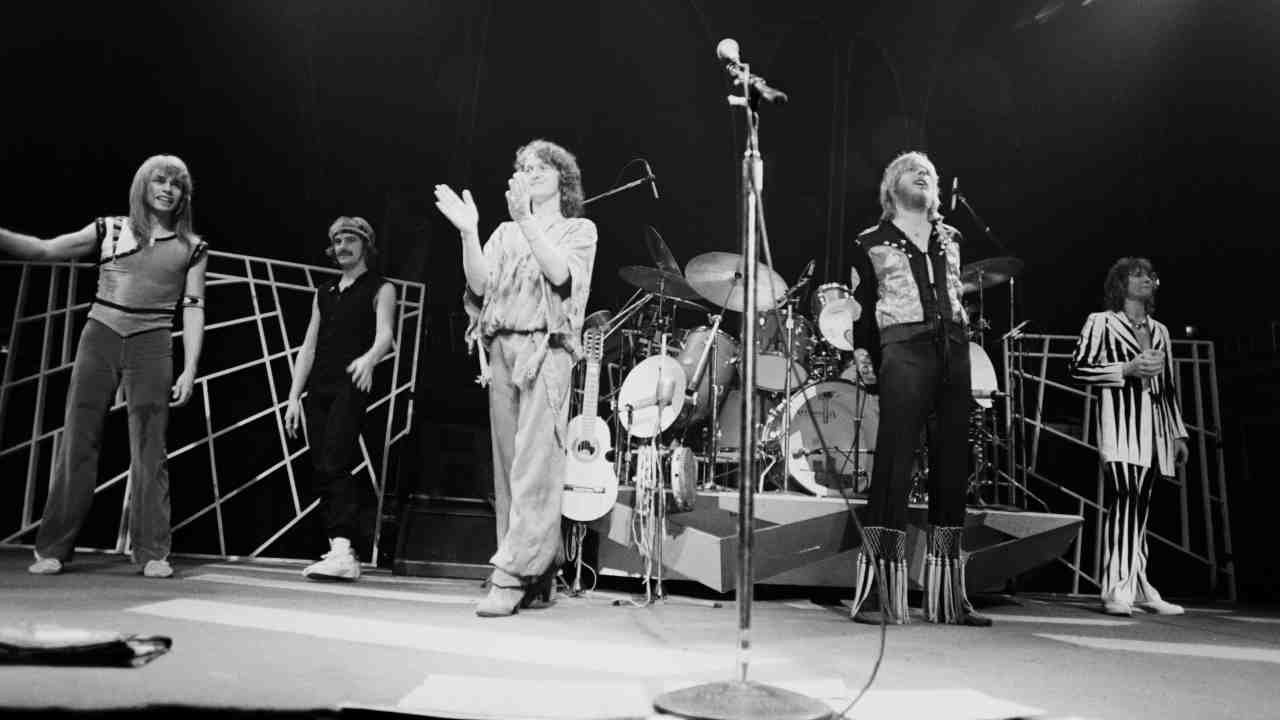
Even the ambition of Tales... paled in comparison to Wakeman’s solo endeavours, in which he allowed his imagination free rein in terms of their production and staging. For all of the records he was selling and money he was making, he was spending it just as fast. It didn’t really occur to him not to do it.
“I think I always would have done what I did,” he says. “I’m not a gambler in the gambling sense of the word, but I’m a blackjack double-up. If I win, then I put all that on the next card. Yes, I had money. But all the money I earned from Six Wives... I put on Journey.... All the money I made on Journey... went to pay for the tour in America, which was guaranteed to lose, because there’s no way you can fly an orchestra all around America. It lost a quarter of a million, which was a fortune in 1974, but it sold shedloads of albums, and that paid for it. The other bits that were left over, I ploughed into King Arthur..., and the shows on ice.
“So I just doubled up. When I did No Earthly Connection, I remember A&M calling an emergency meeting because the sales were only 4.7 million… Suddenly all the money I’d ploughed into that and other things, I was back to zero. I was always back to zero.”
While Wakeman was off having a high old time, Yes had recruited Patrick Moraz and recorded Relayer, an album Wakeman describes as “almost Jazz fusion”. He was relieved when he heard it, not because he didn’t like it but because its direction reinforced his decision to leave. In the autumn of 1976, he took a call from Jon Anderson, who was in Switzerland with Yes. He asked Wakeman if he would listen to a couple of new songs.
“It came a couple of days later and on the cassette were demos by Jon, just voice and guitar, of Going For the One and also Wondrous Stories. I thought, ‘Bloody hell, this is where it should have gone at the end of Yessongs’. So I called Jon up. He was at the Inn Du Lac in Montreaux. I said, ‘Great songs Jon, what’s brought this about? He said, ‘You wouldn’t fancy coming over and playing on it would you?’
Going For The One became another landmark Yes record, containing the song that is perhaps their masterpiece, Awaken, which has Wakeman’s superlative church organ section at its heart. As the Punk wars raged, they recorded and released a follow-up, Tormato.
“I’ve always said Tormato was a great album, just a lousy production,” says Wakeman. “We couldn’t agree how the production could be. There were five of us and five producers, so it had ten pairs of hands on it. It ended up badly compressed and there is no light and shade. Of course, the punk/new wave era was coming into force. We went and toured. Things were dipping a little bit, times were changing.”
Once again, entropy had its way with Rick Wakeman and Yes.
“We ended up in Paris to do a new album. By that time, a bit of a faction had grown up. It was very much Chris and Steve writing together, and Jon and me writing together. Alan White was flitting either side of the fence. We were under a lot of pressure from the record company, over where prog stood in the whole earthly realm of music. I remember [Atlantic boss] Ahmet Ertegun coming to Paris and staying at the George V, and we all went round for dinner. He was really quite concerned and suggested maybe we thought differently, changed things, and that created more factions. Alan went ice-skating and broke his leg, which is a bit tricky for a drummer, and within five minutes, everybody’s packed up and gone home. Jon and I went for a very boozy afternoon in a tiny little café near the studio. We must have drunk a bottle of Calvados. At the end of it, Jon was almost in tears. He said, ‘This isn’t Yes as I had the dream of Yes music; this is going to become about individuals. I can’t be part of this, I’ve got to go’. I said, ‘Jon, if you’re going I’m going, because if you’re going, I’ve not got a hope in hell.’”
In an act of either inspiration or brinkmanship, Anderson and Wakeman were replaced by Geoff Downes and Trevor Horn, both members of synth-pop duo The Buggles, also managed by Brian Lane. Drama, the resulting album, was probably Yes’ low water mark, but it was Horn, a wizard behind the production desk, and a new guitarist, Trevor Rabin, who were central to the next, 90210.
“I wasn’t on it, but that record saved the band,” says Wakeman. “If Trevor Rabin and Trevor Horn hadn’t grabbed it by the scruff of the neck, Yes would have died. So that was probably the most important album Yes ever made.”
After a lukewarm follow-up, Big Generator, Jon Anderson left to work on a solo project called Montserrat, and the curious final stanzas of Wakeman’s long association with the band began. There were now more prominent former members of Yes than there were remaining in the group. Anderson’s solo project morphed into Anderson Bruford Wakeman Howe, who made two albums and toured under the banner ‘an evening of Yes music’, while Chris Squire, along with Tony Kaye and Alan White, were in Yes, which was known to those on the outside, disparagingly, as ‘Yes West’, because they were based in California. Following some managerial manourevring, the two halves were joined as an unwieldy whole for the Union project. An album was made and a tour undertaken, during which Anderson, Bruford, Wakeman and Howe would play for the first half, and Yes, in tandem with Anderson, for the second. Wakeman claims to have heard the Union album just once before throwing his tape copy out of the window of a car.
“As disastrous as the album was, the tour was fantastic,” Wakeman says. “Somehow it worked. Don’t ask me how, and there were factions, but I’d like to think I got on with everybody. I went there to enjoy myself because I’d been tipped the wink, right from day one, that the Yes West management knew they needed Jon, and the whole thing was a ploy to get Jon back. I enjoyed the tour, absolutely fantastic. And when it came to the end, I think it was in Japan, I had plenty of things to do. That was that.”
Except, of course, Yes being Yes, it wasn’t. Wakeman and Howe reunited with the band for three shows at the Freemont Theatre in San Luis Obispo, and contributed to two new songs that appeared on the Keys To Ascension album.
“We found ourselves in a room,” says Wakeman. “Yes had three different managers, all jockeying for position. I didn’t really have one, but I was booked to go out on a solo tour. To cut a long story short, they booked a tour. They said cancel mine. But there were huge cancellation fees, and all the crap that goes with it and anyway, no, you knew about the commitments I had. So sod you.”
He returned for the final time in 2002, for a couple of years of touring that provided him with his happiest times in the band. They were all mature musicians now, able to reflect on the music that was their legacy and interpret it in powerful new ways.
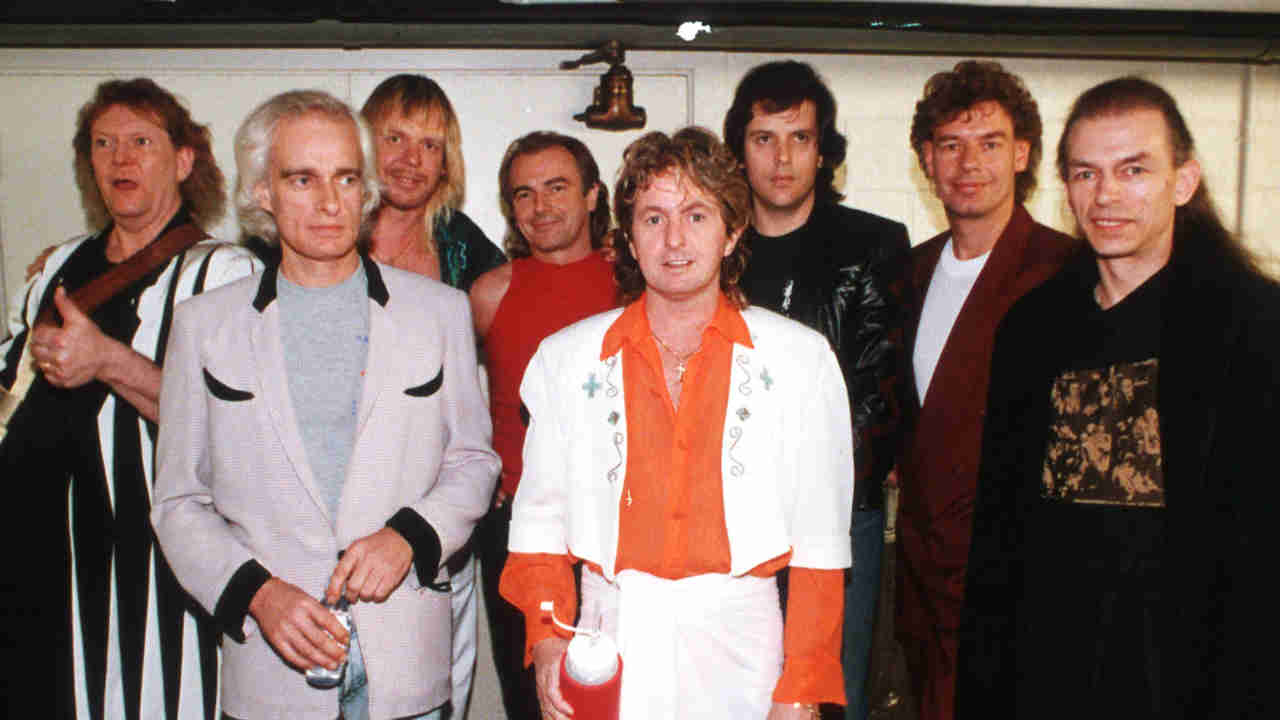
“Technology had moved on, instruments had moved on and I think we’d all to some extent grown up,” says. “It was interesting to see how some of the classic old pieces had developed, and I had some ideas too. We rehearsed up in Seattle, and it was obvious from the start that this was going to work, and it was going to work quickly. And during those years – 2003, 2004 and into 2005, when we toured non-stop – the band was absolutely at the top of its game. It was almost cocky. It was good, and we knew it was good. It was the most perfect time for the line-up to get back together.”
They began to consider writing an album together, but Anderson became seriously ill after an asthma attack, and Wakeman was outvoted by 3-1 on continuing to tour without him.
“It was obvious that it was going to be quite some time for Jon to recuperate,” says Wakeman. “I wanted to wait. I was outvoted by Steve, Chris and Alan, which is absolutely fine, because it’s a democratic band. They wanted to get another singer in, and I said, ‘Well, if you’re going to do that, I can’t go with you. Morally I think it’s wrong and musically I think it’s wrong’. I met with Chris in London, we had a chat. He asked me to recommend someone, and the only two people I could recommend were my sons. Adam’s played with the band already and knows the songs, but he was unbelievably happy with Ozzy (Osbourne). Oliver had made an acoustic album with Steve Howe. The next thing I know I get a call from Oliver – ‘ How would you feel, dad?’ I said, ‘You owe me a dinner, son…’ And that was it.
Whether it is or not, perhaps not even Rick Wakeman really knows. However busy he is, Yes is the thread that has run through his life.
“The interesting thing is that there were only really two times I left,” he says, by way of a conclusion. “In 1974, because of the way the music was. And then with Jon, at the end of 1979, again because of the music. All the other times have been because of circumstances within the band or the management. And in answer to your next question, the answer is no. Not in a million years. Yes peaked from 2002-5, and couldn’t get back to that. I want to have that memory of knowing I was part of the band when it was in peak condition.”
He pauses for a final time, searching for the perfect sign-off. “You know what?’ he says. “If we’d been a dog we would have won Crufts…”
Originally published in Classic Rock Presents Rick Wakeman’s Journey To The Centre Of The Earth







